Welcome to the latest selection of recent top articles in the physica status solidi journals. Get a glimpse of our publication spectrum and visit our pages by clicking on any of the DOI links below.
Silicon nanowires – a versatile technology platform [Review@RRL]
Thomas Mikolajick, André Heinzig, Jens Trommer, Sebastian Pregl, Matthias Grube, Gianaurelio Cuniberti, and Walter M. Weber
![]() Based on their inherent small diameter, silicon nanowires offer unique properties that enable electron devices, sensors as well as solar cells and lithium batteries with the potential to significantly outperform their thin film or bulk counterparts. This article gives an overview of important device applications of silicon nano-wires. Starting with nanowire fabrication, the different device concepts are introduced and their most important features reviewed. Special focus is put on different reconfigurable transistor concepts recently described in literature.
Based on their inherent small diameter, silicon nanowires offer unique properties that enable electron devices, sensors as well as solar cells and lithium batteries with the potential to significantly outperform their thin film or bulk counterparts. This article gives an overview of important device applications of silicon nano-wires. Starting with nanowire fabrication, the different device concepts are introduced and their most important features reviewed. Special focus is put on different reconfigurable transistor concepts recently described in literature.
Phys. Status Solidi RRL (2013) DOI 10.1002/pssr.201307247
Wafer thickness optimization for silicon solar cells of heterogeneous material quality [Rapid Research Letter · rrl solar]
Bernhard Michl, Martin Kasemann, Wilhelm Warta, and Martin C. Schubert
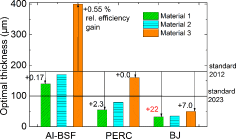 The optimal wafer thickness for multicrystalline silicon solar cells depends on the relation of bulk to surface recombination and the light trapping. For multicrystalline silicon bulk recombination strongly varies laterally and with injection level. A thickness optimization using the “Efficiency Limiting Bulk Recombination Analysis” (ELBA) takes all these effects correctly into account. The optimal thickness for different material types is calculated. The efficiency gain differs strongly for different technologies.
The optimal wafer thickness for multicrystalline silicon solar cells depends on the relation of bulk to surface recombination and the light trapping. For multicrystalline silicon bulk recombination strongly varies laterally and with injection level. A thickness optimization using the “Efficiency Limiting Bulk Recombination Analysis” (ELBA) takes all these effects correctly into account. The optimal thickness for different material types is calculated. The efficiency gain differs strongly for different technologies.
Phys. Status Solidi RRL (2013) DOI 10.1002/pssr.201308090
A micro-electro-mechanical memory based on the structural phase transition of VO2 [Advanced Materials Physics]
Rafmag Cabrera, Emmanuelle Merced, and Nelson Sepúlveda
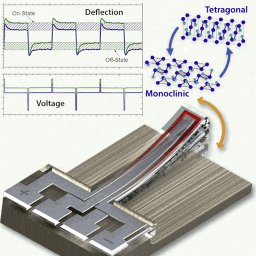 The work by Cabrera et al. presents a significant improvement in the previous advances on the memory applications of vanadium dioxide. The authors demonstrate a monolithically integrated micro-electromechanical (MEMS) memory device, where the mechanical states are programmed solely by electric signals. The fundamental operation of the device is based on the structural phase transition and the inherent hysteretic behavior of vanadium dioxide thin films. Although the phase change of the multifunctional VO2 thin films comes with abrupt changes in the material properties, a control system was implemented and the system is designed to be very robust for fluctuating background temperatures.
The work by Cabrera et al. presents a significant improvement in the previous advances on the memory applications of vanadium dioxide. The authors demonstrate a monolithically integrated micro-electromechanical (MEMS) memory device, where the mechanical states are programmed solely by electric signals. The fundamental operation of the device is based on the structural phase transition and the inherent hysteretic behavior of vanadium dioxide thin films. Although the phase change of the multifunctional VO2 thin films comes with abrupt changes in the material properties, a control system was implemented and the system is designed to be very robust for fluctuating background temperatures.
Phys. Status Solidi A (2013) DOI 10.1002/pssa.201330021
Inorganic nanotubes and fullerene-like nanoparticles: synthesis, mechanical properties and applications [Invited Article]
R. Tenne, R. Rosentsveig, and A. Zak
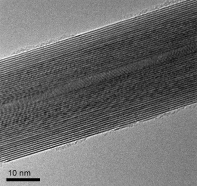 In this article the synthesis of inorganic nanotubes (INT) and to a lesser extent, inorganic fullerene-like nanoparticles (IF) of WS2, which have been recently scaled-up, is discussed in some detail. Subsequently the mechanical properties of IF/INT are summarized, in reference to their remarkable possibility to reinforce polymer matrices and serve as superior solid lubricants. The effect of adding minute amounts of such nanoparticles to various polymer matrices is reviewed with reference to thermoplastic and thermosetting polymers. Possible different applications of such nanocomposites are also briefly discussed.
In this article the synthesis of inorganic nanotubes (INT) and to a lesser extent, inorganic fullerene-like nanoparticles (IF) of WS2, which have been recently scaled-up, is discussed in some detail. Subsequently the mechanical properties of IF/INT are summarized, in reference to their remarkable possibility to reinforce polymer matrices and serve as superior solid lubricants. The effect of adding minute amounts of such nanoparticles to various polymer matrices is reviewed with reference to thermoplastic and thermosetting polymers. Possible different applications of such nanocomposites are also briefly discussed.
Phys. Status Solidi A (2013) DOI 10.1002/pssa.201329309
Electronic structure of defects and doping in ZnO: Oxygen vacancy and nitrogen doping [Editor’s Choice]
Adisak Boonchun and Walter R. L. Lambrecht
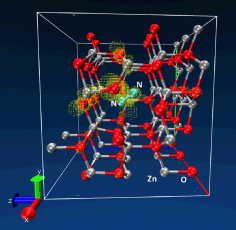 While atomic nitrogen on the oxygen site in ZnO has too deep a level for p-type doping, a nitrogen molecule (N2) sitting on the Zn site is shown by means of first-principles calculations to have a shallow delocalized defect state suitable for p-type doping. The hyperfine structure and g -factor of the proposed N2 on Zn model are consistent with a previously observed Electron Paramagnetic Resonance center in ZnO. The identification of the shallow level with N2 on Zn, results in several new recommendations for achieving p-type doping: (i) work in Zn-poor, O-rich conditions, (ii) use N2 rather than atomic or excited or other N species such as NO, NH3 to incorporate nitrogen, (iii) as already established experimentally, use the Zn-polar surface. The recommendation (i) has the added benefit of avoiding oxygen vacancies and the recommendation (ii) has the advantage of avoiding H incorporation as a compensating n-type donor.
While atomic nitrogen on the oxygen site in ZnO has too deep a level for p-type doping, a nitrogen molecule (N2) sitting on the Zn site is shown by means of first-principles calculations to have a shallow delocalized defect state suitable for p-type doping. The hyperfine structure and g -factor of the proposed N2 on Zn model are consistent with a previously observed Electron Paramagnetic Resonance center in ZnO. The identification of the shallow level with N2 on Zn, results in several new recommendations for achieving p-type doping: (i) work in Zn-poor, O-rich conditions, (ii) use N2 rather than atomic or excited or other N species such as NO, NH3 to incorporate nitrogen, (iii) as already established experimentally, use the Zn-polar surface. The recommendation (i) has the added benefit of avoiding oxygen vacancies and the recommendation (ii) has the advantage of avoiding H incorporation as a compensating n-type donor.
Phys. Status Solidi B (2013) DOI 10.1002/pssb.201300010
Modeling charge transport in DNA using multi-scale methods [Feature Article]
Tomás Kubar, Rafael Gutiérrez, Ulrich Kleinekathöfer, Gianaurelio Cuniberti, and Marcus Elstner
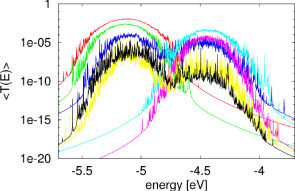 Despite great efforts in the experimental and theoretical investigation of charge migration in DNA oligomers, no unified explanation of the microscopic mechanisms governing charge transfer/transport has been achieved up to date. The complexity of this bio-molecule as well as the variety of factors that influence charge transfer/transport make the available experimental data difficult to analyze unambiguously. Thus, theory and computation play a prominent role by guiding experimental studies and providing them with well-defined predictions. A fundamental problem in such systems is the strong coupling of electronic and structural degrees of freedom, which makes a treatment based on standard perturbation theory unfeasible in general. This review focuses on various methodological approaches relying on an efficient combination of accurate electronic structure calculations, classical molecular dynamics and charge transport approaches to describe charge migration in complex (bio)molecular systems.
Despite great efforts in the experimental and theoretical investigation of charge migration in DNA oligomers, no unified explanation of the microscopic mechanisms governing charge transfer/transport has been achieved up to date. The complexity of this bio-molecule as well as the variety of factors that influence charge transfer/transport make the available experimental data difficult to analyze unambiguously. Thus, theory and computation play a prominent role by guiding experimental studies and providing them with well-defined predictions. A fundamental problem in such systems is the strong coupling of electronic and structural degrees of freedom, which makes a treatment based on standard perturbation theory unfeasible in general. This review focuses on various methodological approaches relying on an efficient combination of accurate electronic structure calculations, classical molecular dynamics and charge transport approaches to describe charge migration in complex (bio)molecular systems.
Phys. Status Solidi B (2013) DOI 10.1002/pssb.201349148
















